English
Hi all, this time I want to share an amazing trip that me and my wife did yesterday at Venice, next to Frari, in the "Scuola Grande di San Rocco" to see a marvellous example of Renaissance architecture and watch all the paintings inside it, overall from Jacopo Robusti better known as Tintoretto
Italiano
Salve a tutta la community, quest'oggi voglio condividere una fantastica visita che abbiamo fatto ieri io e mia moglie a Venezia centro, vicino ai Frari, per vedere la Scuola Grande di San Rocco, un esempio meraviglioso di architettura rinascimentale, al cui interno risiedono alcuni dei maggiori quadri di Jacopo Robusti, meglio noto come Il Tintoretto
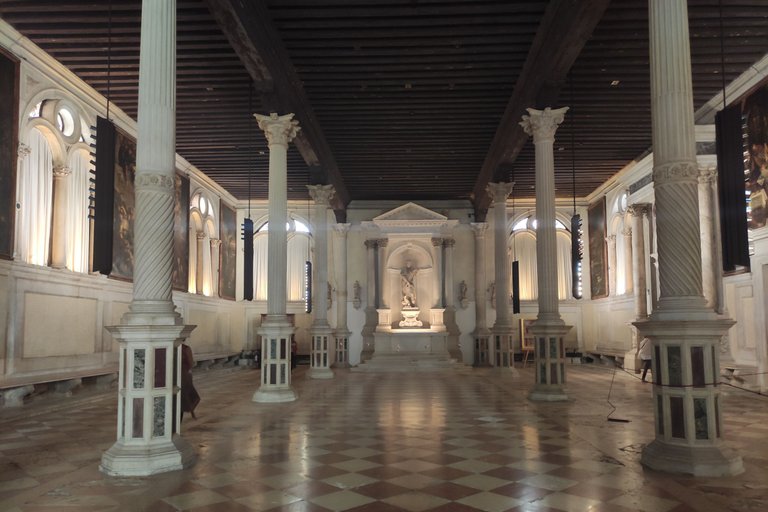
Ground Floor (known as Sala Terrena) - Perspective view from the entrance
Sala Terrena - Veduta Prospettica dall'ingresso
English
A little bit of historical background
In the heart of the “Sestrier” of San Polo in Venice in 1517 was built the “Scuola Grande di San Rocco” also known as "the Venetian Sistine" whose project was initially entrusted to Pietro Bon and then completed both inside and outside by Scarpagnino. with a distinctly Renaissance style with the typical distribution of the other Venetian “Scuole”.
But what was a “Scuola”?
The “Scuola” were brotherhoods where the adepts were frequently bourgeois, craftsmen and Venetian professionals who in this way participated in the social life of the city from the religious sector to real social assistance through charity, in fact the members were economically very wealthy.
In particular, the “Scuola Grande” was founded in 1478 in honor of San Rocco venerated by the faithful after the first epidemic of plague.
Italiano
Un pò di notizie storiche.
Nel cuore del “Sestrier” di San Polo a Venezia è stata edificata nel 1517 La Scuola Grande di San Rocco conosciuta anche come “la Sistina Veneziana” il cui progetto fu affidato inizialmente a Pietro Bon e poi completato sia all’interno che all’esterno dallo Scarpagnino con uno stile nettamente rinascimentale con la distribuzione tipica delle altre scuole veneziane.
Ma cos’era una Scuola?
Le Scuole erano delle confraternite dove gli adepti erano frequentemente borghesi, artigiani e professionisti veneziani che in questo modo partecipavano alla vita sociale della città dal settore religioso all’assistenza sociale vera e propria attraverso la carità, infatti i membri erano economicamente molto agiati.
In particolare la scuola grande viene fondata nel 1478 in onore a San Rocco venerato dai fedeli dopo la prima epidemia di peste.
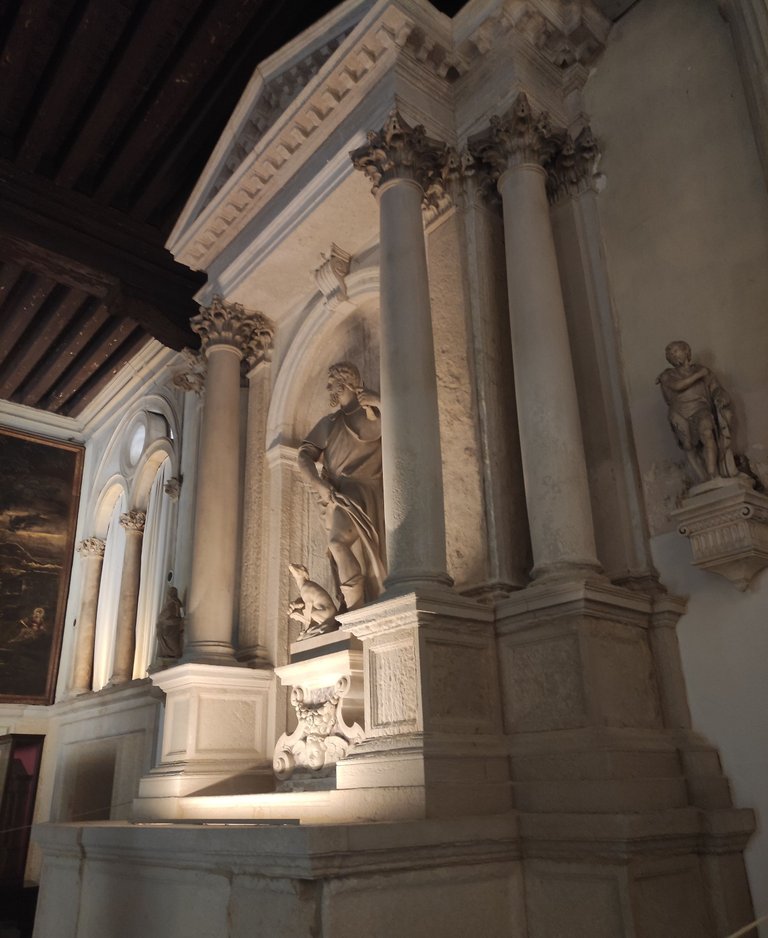
San Rocco Statue
Statua di San Rocco
English
Initially it was based in the “Scoletta” ( little Scuola) located in front of where nowadays the current Scuola is located , but thanks to the generous offers it became one of the most powerful brotherhoods of the lagoon city that still survives today with its followers after all the Scuole were suppressed by a Napoleonic decree. In fact it was revoked only for the “Scuola Grande di San Rocco”.
The Scuola Grande is a real receptacle for Venetian Renaissance artists in fact it houses paintings first of all by Tintoretto, but we also find paintings by
Tiziano - Annunciation (L’Annunciazione) located in the staircase (57)
Giorgione - The Christ carrying the cross (Il Cristo portacroce) at the top of the staircase of the Treasure (54)
Tiepolo - Abraham and the angels and Hagar and Ishmael (Abramo e gli angeli e Agar e Ismaele) (53a/b) at the bottom of the scale of the Treasury.
Italiano
Inizialmente ha sede nella scoletta posta di fronte all’attuale Scuola, ma grazie alle generose offerte divenne una delle confraternite piu potenti della citta lagunare e che sopravvive ancora oggi con i suoi adepti dopo che con decreto Napoleonico furono soppresse tutte le scuole ma venne revocato solo per la scuola grande di San Rocco.
La scuola grande è un vero e proprio ricettacolo degli artisti rinascimentali veneziani infatti ospita dipinti primo tra tutti del Tintoretto, ma troviamo anche dipinti del:
Tiziano - L'Annunciazione situato nello scalone (57)
Giorgione - Il Cristo Portacroce nella parte superiore della Scala del Tesoro (54)
Tiepolo - Abramo e gli angeli e Agar e Ismaele (53a/b) nella parte inferiore della Scala del Tesoro.
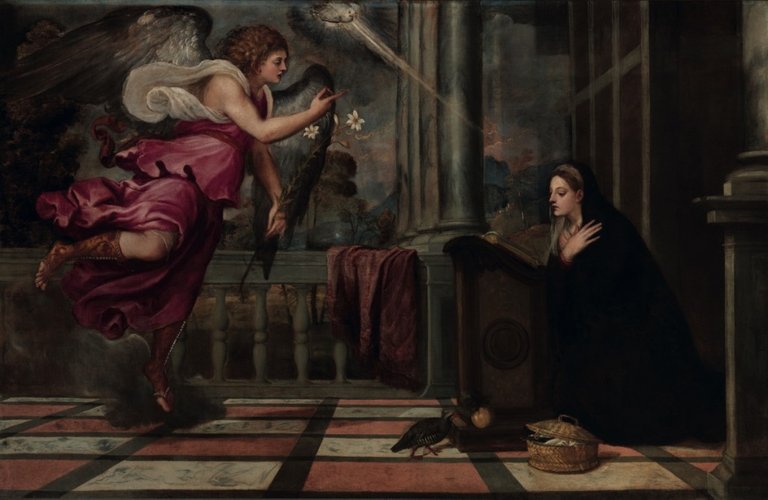
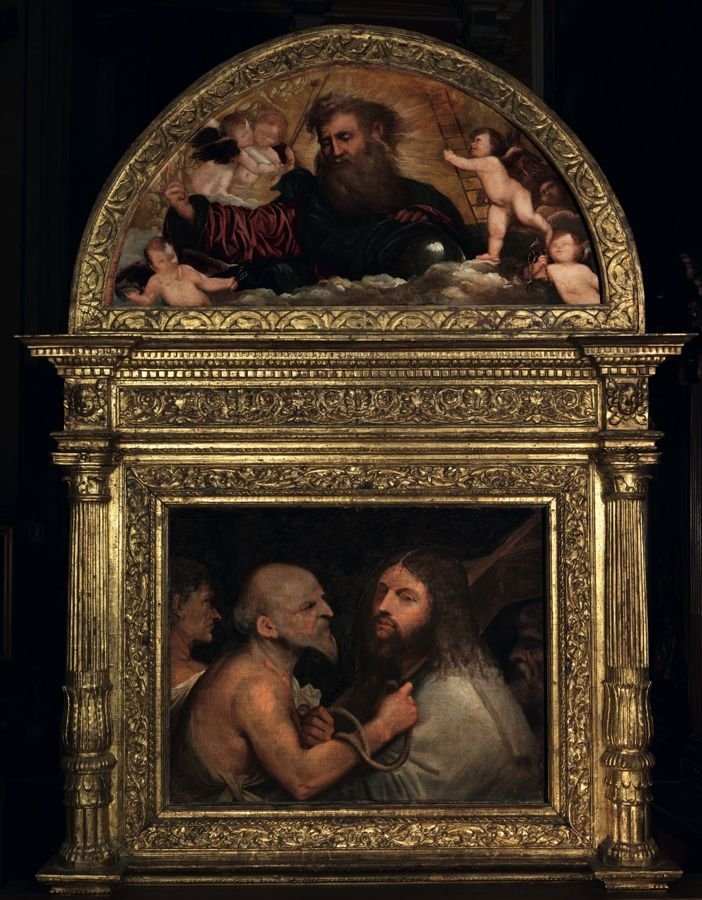
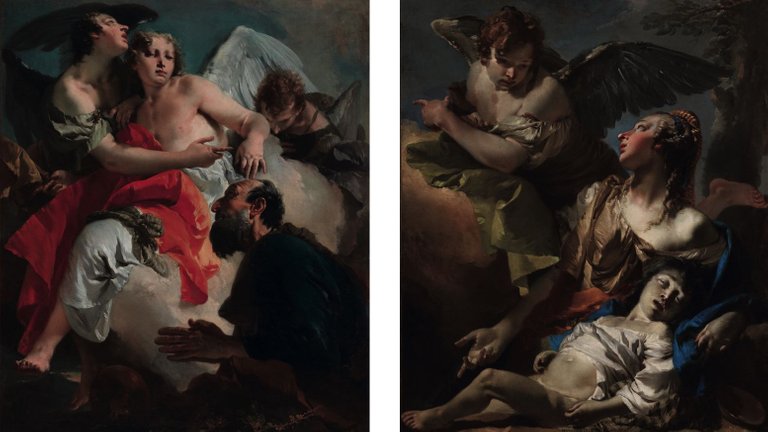
English
In the lateral side of the staircase leading to the "Sala Capitolare" we find two large canvases placed after the last plague that struck Venice. In 1666 Zanchi depicted the Virgin appears to the plague victims on the left side of the staircase, and in 1678 Negri depicts the Madonna saves Venice from the Plague on the right side.
However the main artist who painted the artworks preserved in the Scuola Grande was Jacopo Robusti known as Il Tintoretto who created his personal "Sistine chapel" in Venice.
Italiano
Nelle parti laterali dello scalone che porta alla Sala Capitolare troviamo due ampi teleri posti dopo l’ultima peste che colpì Venezia, nel 1666 lo Zanchi raffigurò nella parte sinistra dello scalone La Vergine appare agli appestati, nel 1678 Negri raffigura nella parte destra La Madonna salva Venezia dalla Peste.
Principale artista che lavorò alle opere conservate nella scuola fu Jacopo Robusti detto Il Tintoretto che realizzo la sua personale “ cappella Sistina “ a Venezia.
SALA TERRENA
Tintoretto's pictorial cycle
Ciclo Pittorico del Tintoretto
English
Chronologically it is the last room decorated by the painter in work from 1582 to 1588 to create the cycle which is dedicated to the Virgin.
The access to the “Scuola Grande” takes place from the large “Terrena” ground floor hall divided into three naves
In the background of the central nave the votive altar dominates with the statue of San Rocco set in place, welcoming visitors and focusing their attention, while the two side ones are decorated with paintings depicting the first phase of Jesus' story, in fact we find on the left:
Annunciation -45-
Italiano
Cronologicamente è l’ultima sala decorata dal pittore in opera dal 1582 al 1588 per realizzare il ciclo che è dedicato alla Vergine.
L’accesso alla scuola avviene dalla ampia Sala Terrena divisa in tre navate, nello sfondo della navata centrale domina l’altare votivo con incastonata la Statua di San Rocco che accoglie i visitatori accentrandone l’attenzione.
Mentre le due navate laterali sono decorate con tele raffiguranti la prima fase della storia di Gesù, infatti troviamo a sinistra
L'Annunciazione -45-
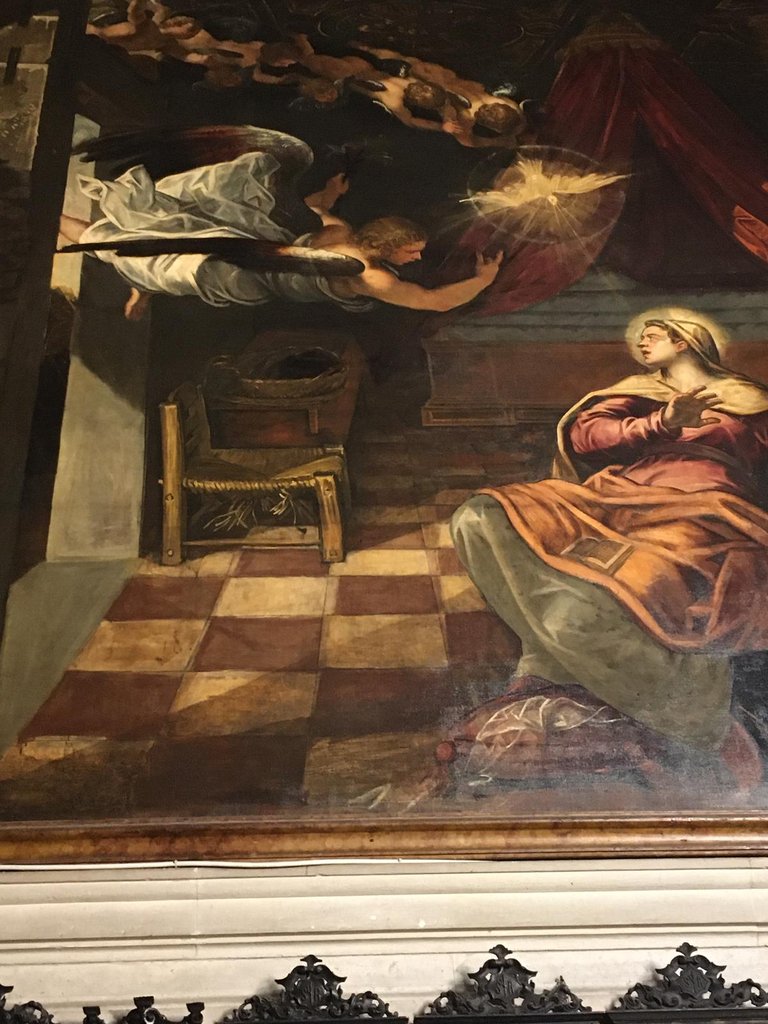
Description
The archangel Gabriele in his movement seems to accompany the visitor inside the nave, an iconographic peculiarity that the painter inserted as a symbolic gesture. Gabriele has a corpulent figure and with the dove and the seraphs they seem to weigh on the space of an astonished virgin who abruptly interrupts the daily actions during which she is surprised and which suddenly are broken forever.
Descrizione
L’arcangelo Gabriele nel suo movimento sembra accompagnare il visitatore all’interno della navata, particolarità iconografica che il pittore inserisce come gesto simbolico. Gabriele ha una figura corpulenta e con la colomba ed i serafini sembrano gravare sullo spazio di una vergine stupita che interrompe bruscamente le azione quotidiane durante le quali viene sorpresa e che d’improvviso vengono infrante per sempre.
English
Adoration of the Magi -46-
Escape into Egyp-47-
Italiano
Adorazione dei Magi -46-
Fuga in Egitto -47-

Description
The composition seems to recall the shape of the windows in the wall, through the palms at the top of the painting. The dynamism of the scene is given by the representation of a natural environment, clearly depicting the Venetian countryside, in its everyday life and simplicity that is contrasted with the group of three figures with red and blue ultramarine robes, which plastically push forward as if to tear the simplicity they are framed in..
Descrizione
La composizione sembra richiamare la forma delle finestre nella parete, attraverso le palme nella parte in alto del dipinto. Il dinamismo alla scena viene dato dalla rappresentazione di un ambiente naturale, chiaramente raffigurante la campagna veneta, nella sua quotidianità e semplicità che viene contrapposto al gruppo delle tre figure con vesti rosse e azzurre oltremare, che plasticamente si spingono in avanti quasi a squarciare la semplicità nella quale sono incorniciati.
Massacre of the Innocents -48-
Massacro degli Innocenti -48-
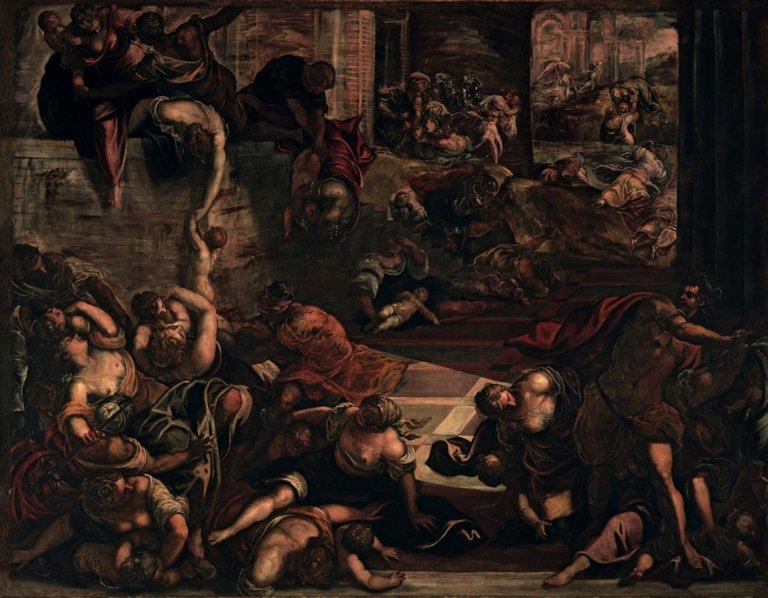
Description
Perhaps the most original painting for its crudeness in representing the plastic and desperate figures of these mothers who oppose the soldiers by grabbing the blade of their sword in an unequal and atrocious struggle. The artist renders the depth of perspective well through a few brushstrokes that create the blurred background of a scene that highlights the well-defined figures with the clothes of a warm crimson red.
Descrizione
Forse il dipinto più originale per la sua crudezza nel rappresentare le figure plastiche e disperate di queste madri che si oppongono ai soldati afferrandone la lama della spada in una lotta impari ed atroce. L’artista rende bene la profondità prospettica attraverso poche pennellate che creano lo sfondo sfocato di una scena che mette in risalto le figure ben definite con le vesti di un caldo rosso cremisi.
Saint Mary Magdalen -49- in front of
Holy Mary if Egypt -50-Santa Maria Maddalena -49- di fronte a
Santa Maria Egiziaca -50-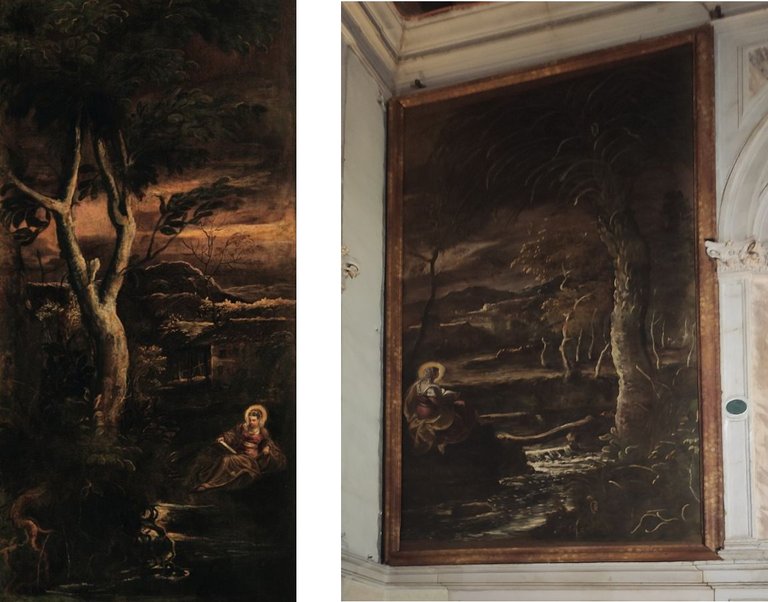
Description
Placed at the end of the cycle is a work that can be read at the representation of Mary opposite on the left wall. Both works portray Mary first in the act of reading and then in contemplation surrounded by a natural environment, in this more spiritual than narrative context the virgin seems to pull the strings of the narration of the works of the entire room read first by the prophecies and looking after the happenings. This is one of the interpretations that are proposed given the hermeticism of the works, but it seems to have been corroborated by the latest findings on the mantle of the figure that was originally blue in color before it oxidized, which in tradition symbolizes the Virgin. the contemplation of Mary appears to transfigure reality and is the full expression of the painter's mystical inclination. The natural landscape made with quick brush strokes and a monochrome palette reveals the late style of the painter.
Descrizione
posta alla fine del ciclo è un’opera che va letta alla rappresentazione di maria dirimpetto nella parete sinistra. Entrambe le opere ritraggono Maria prima nell’atto della lettura e poi in contemplazione attorniata da un ambiente naturale, in questo contesto più spirituale che narrativo la vergine sembra tirare le fila della narrazione delle opere dell’intera sala lette prima dalle profezie e guardando dopo gli accadimenti. Questa è una delle interpretazioni che vengono proposte visto l’ermetismo delle opere, ma sembra essere stato avvalorato da ultimi riscontri sul manto della figura che originariamente, prima che si ossidasse era di colore azzurro, che nella tradizione simboleggia la Vergine. la contemplazione di Maria sembra che trasfiguri la realtà ed è la piena espressione dell’inclinazione mistica del pittore. Il paesaggio naturale realizzato con pennellate rapide e tavolozza monocroma rivela lo stile tardo del pittore.
Circumcision -51-
Assumption of Mary -52-
Circoncisione -51-
Assunzione di Maria -52-

51
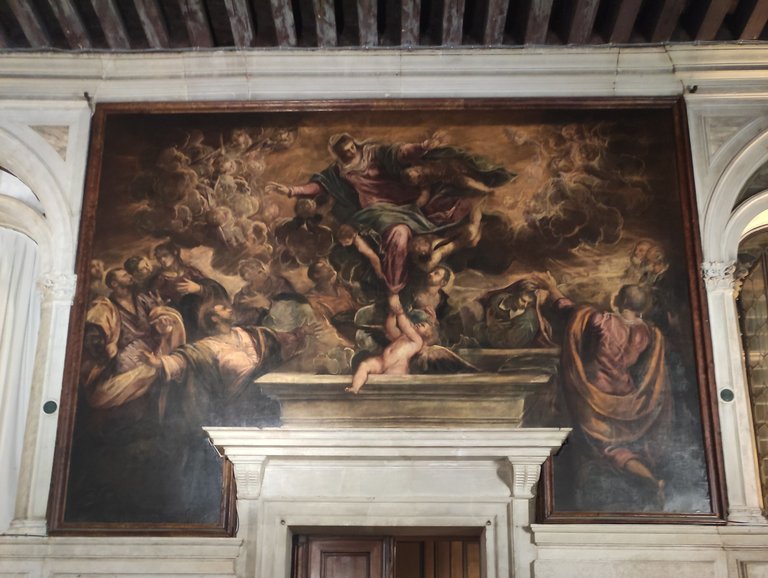
52
Sala Terrena Scheme / Schema
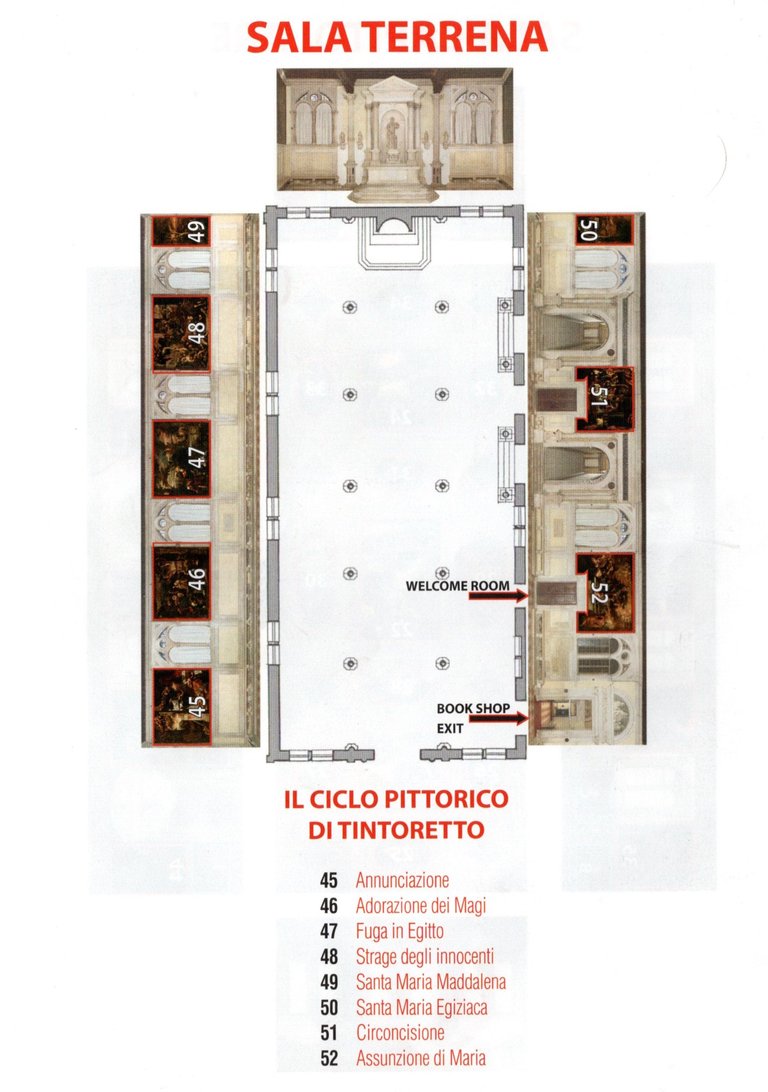
SALA CAPITOLARE
English
And from here we go through a big staircase to the First Floor.
On the upper floor connected by the staircase we find the "Chapter Room" (Sala Capitolare) which combines episodes from the old and new testaments to represent the saving power.
The ceiling is entirely decorated with wooden inlays that frame three groups of oil paintings depicting episodes from the old testament, chronologically executed after the cycle of the hotel room. In fact, in 1575 he was commissioned to design the central canvas and later the painter proposed to complete the decoration of the ceiling, having only the costs of the materials paid, finding the agreement of the brotherhood.
Once the work was completed in 1577, he agreed with the brotherhood to complete the entire decoration of the school in exchange for a life-time annuity and also in this case he obtained it.
The cycle of Moses is connected by theme to the canvases of the walls and is made with the technique of illusionism, used for the paintings for ceilings, in which the figures have an angle of 45 degrees, but the peculiarity given by the Tintoretto are the most points of view that give a mobile sense to the scene
The central group made up of:a large rectangular canvas
Erection of the bronze snake -22-
Italiano
E da qui si sale attraverso una grande scalinata al primo piano.
Nel piano superiore collegata dallo scalone troviamo la Sala Capitolare che unisce episodi del vecchio e del nuovo testamento per rappresentare il potere salvifico.
Il soffitto è interamente decorato con intarsi lignei che fanno da cornice a tre gruppi di tele realizzate ad olio raffiguranti episodi del vecchio testamento, cronologicamente realizzate dopo il ciclo della sala dell’albergo. Infatti gli viene commissionato nel 1575 la tela centrale ed in seguito il pittore proporrà di completare la decorazione del soffitto vedendosi corrisposto le sole spese dei materiali, trovando l’accordo dei confratelli.
Terminato il lavoro nel 1577 si accorda con la confraternita per completare l’intera decorazione della scuola in cambio di un contenuto vitalizio ed anche in questo caso gli fu accordato.
Il ciclo di Mosè si collega per tema ai telari delle pareti e viene realizzato con la tecnica dell’illusionismo, utilizzata per i dipinti per soffitti, in cui le figure hanno un angolo di 45 gradi, ma la peculiarità data dal Tintoretto sono i più punti di vista che danno senso mobile alla scena.
Il gruppo centrale composto da:una tela grande rettangolare
Erezione del serpente di bronzo -22-
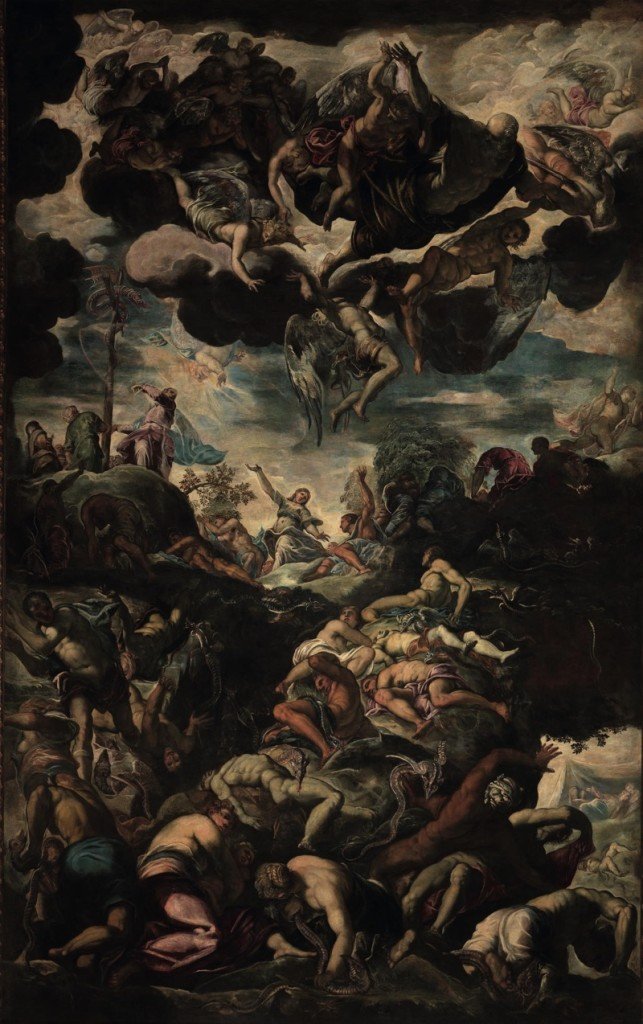
Description
The largest canvas seen up to that moment in Venice represents the relationship between the Eucharist which protects against divine punishment. Snakes represent the plague that periodically afflicts the city. The crowd depicted below seems to have been taken from the damned of Michelangelo's Last Judgment.
Descrizione
La tela più grande vista fino a quel momento a Venezia rappresenta il rapporto tra eucarestia che protegge da punizione divina. I serpenti rappresentano la peste che periodicamente affligge la città. La folla rappresentata in basso sembra essere ripresa dai dannati del giudizio universale di Michelangelo.
two ellipticals respectively represent
Ezekiel's Vision -29-
Jacob's Ladder -30-
Due ellittiche rispettivamente rappresentano
Visione di Ezechiele -29-
Scala di Giacobbe -30-
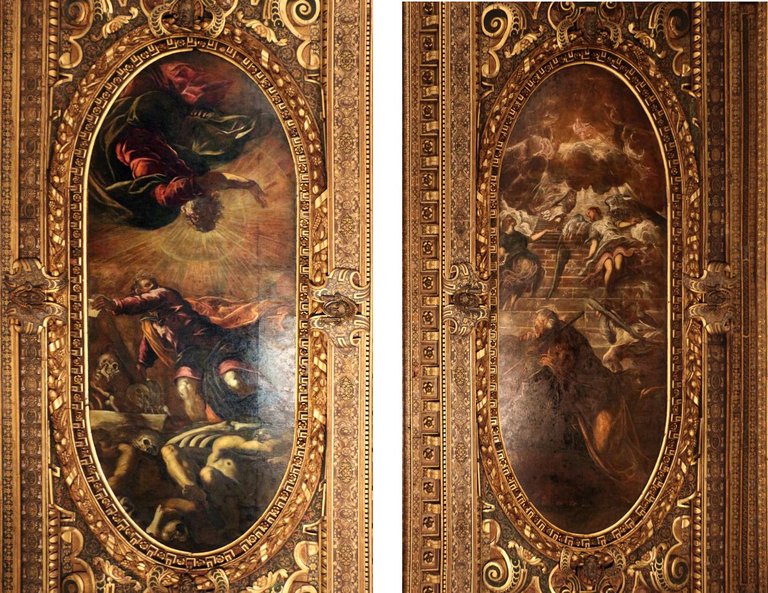
The side group towards the altar composes:
An oil painting on canvas with a square shape in the center depicting the
Gathering of the manna -24-
on each side of the square is placed a canvas of a smaller size with an elliptical shape and each one respectively represents:Elijah fed by the angel -33-
Easter of Jews -34-
Elisha multiplies the bread -32-
Isaac's sacrifice -31-
Il gruppo laterale verso l’altare compone:
un dipinto olio su tela di forma quadrata al centro raffigurante
Raccolta della manna -24-
ad ogni lato del quadrato e posto una tela di formato inferiore a forma elittica ed ognuna rispettivamente rappresenta:
Elia nutrito dall’angelo -33-
Pasqua degli Ebrei -34-
Eliseo moltiplica i pani -32-
Sacrificio d’Isacco -31-
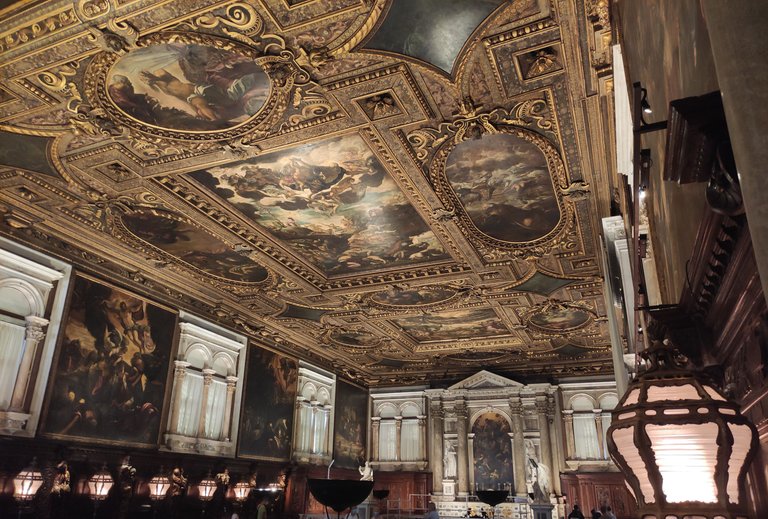
English
While the side group adjacent to the back wall with the same geometric rhythm represents in the center:
Moses makes water gush out of the rock-23-
Here the protagonist light makes the representation assume a fantastic atmosphere, illuminating the figures in the foreground in their plasticity and the diaphanous figures in the background giving a sense of depth to the composition.
The lateral elliptical canvases :
Jonah comes out of the whale's belly -28-
Hermitage appears to Moses -26-
Adam and Eve -25-
Pillar of Fire -27-
Italiano
Mentre il gruppo laterale adiacente alla parete di fondo con lo stesso ritmo geometrico rappresenta al centro:
Mosè fa scaturire l’acqua dalla roccia -23-
La luce protagonista fa assumere alla rappresentazione un’atmosfera fantastica, illuminando le figure in primo piano nella loro plasticità e le figure diafane sullo sfondo dando senso di profondità alla composizione.
le tele ellittiche laterali
Giona esce dal ventre della balena -28-
L’eremo appare a Mosè -26-
Adamo ed Eva -25-
Colonna di fuoco -27-

23 - 25 - 26 - 27 - 28
English
The side walls in the lower part boast wooden decorations with allegorical sculptures made by F. Pianta made in the 18th century, in particular under the second mullioned window from the altar on the right wall Tintoretto himself is represented with Cicero.
In the presbytery, Giovanni Marchiori created 24 wooden bas-reliefs in 1741 and 1743 that cover the cabinets depicting the life of San Rocco.
Tintoretto decorates the walls with episodes from the life of Jesus depicting on the left wall of the altar from the bottom:
Adoration of Shepherds -35-
Italiano
Le pareti laterali nella parte inferiore vantano decorazioni Lignee con sculture allegoriche realizzate da F. Pianta realizzate nel 700, in particolare sotto la seconda bifora dall’altare della parete destra è rappresentato lo stesso Tintoretto con Cicerone.
Nel presbiterio Giovanni Marchiori realizzò 24 bassorilievi in legno nel 1741 e 1743 che ricoprono gli armadi raffiguranti la vita di San Rocco.
Il Tintoretto decora le pareti con episodi della vita di Gesù raffiguranti nella parete sx all’altare dal fondo:
Adorazione dei pastori 35
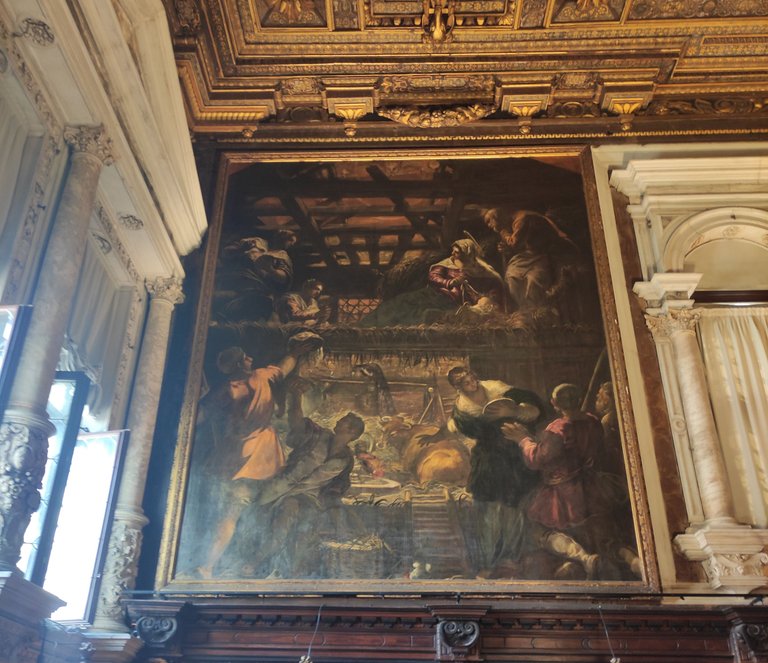
35
Description
The pictorial composition of the canvas is on two levels and tells the scene of the birth of Christ the bearer of redemption whose humility in comparison with the great value it will assume for all humanity, is given by the dilapidated environment of the ruined and dark building, from which emerge the only plastic figures in the foreground illuminated by a light that penetrates from the ceiling beams.
Descrizione
La composizione pittorica della tela è in due livelli e si narra la scena della nascita di Cristo portatore di redenzione la cui umiltà a raffronto del grande valore che assumerà per l’intera umanità, è data dall’ambiente fatiscente dell’edificio diroccato e scuro, dal quale emergono le sole figure plastiche in primo piano illuminate da una luce che penetra dalle travi del soffitto.
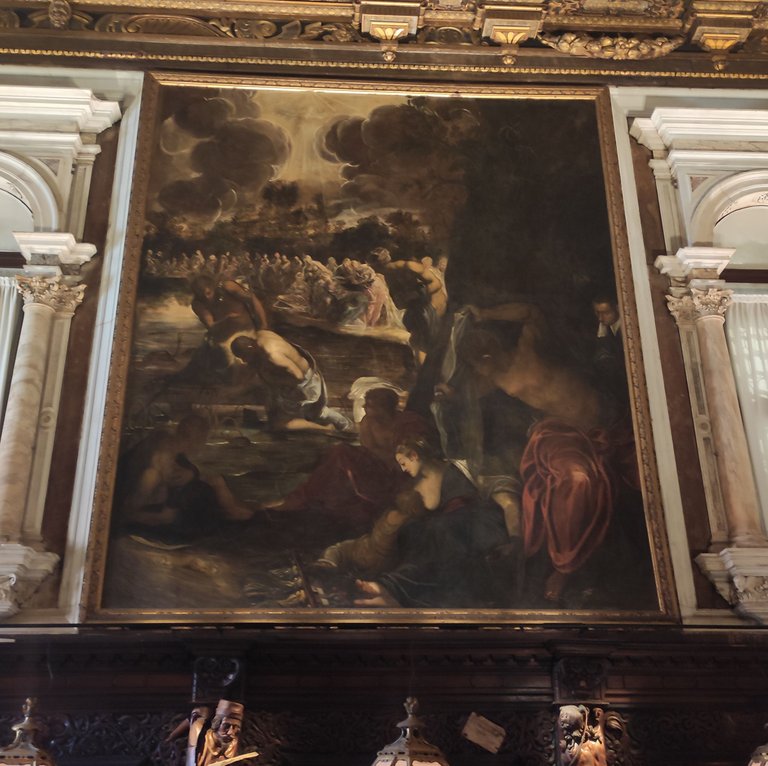
36
Description
Choral and original composition with respect to the theme's pictorial tradition. The background of the scene is dark and brings out the light that radiates from above, illuminating Christ, bringing the figure into the foreground for the viewer's gaze. Behind the two plastic figures of Christ and John is the diaphanous crowd, thus giving a perspective sense of depth to the composition.
Descrizione
Composizione corale ed originale rispetto alla tradizione pittorica del tema. Lo sfondo della scena è scuro e fa risaltare la luce che irradia dall’alto illuminando Cristo portandone la figura in primo piano allo sguardo dello spettatore. Alle spalle delle due figure plastiche di Cristo e Giovanni vi è la folla diafana, dando così un senso prospettico di profondità alla composizione.
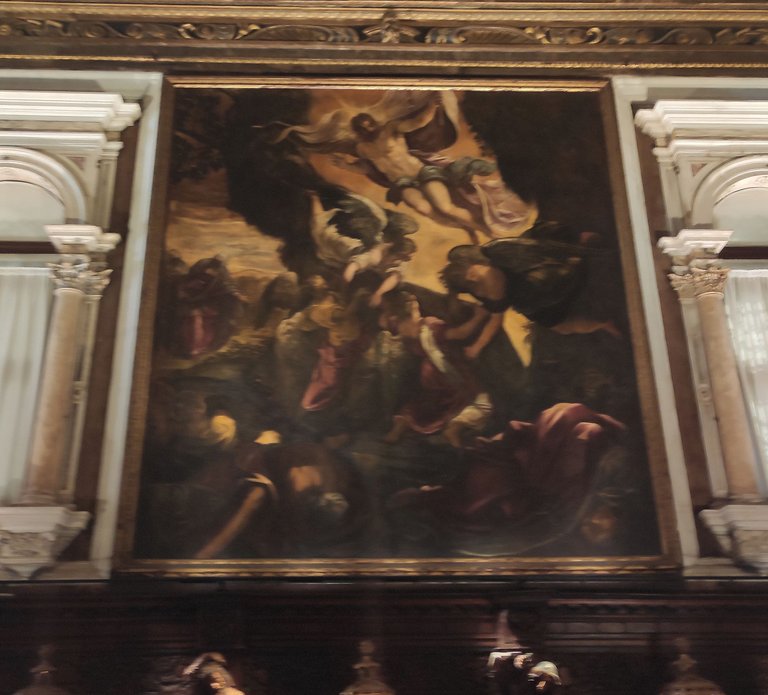
Description
Large work whose zigzag composition sees the figure of the risen Christ enveloped by the splendor of light, emerging diagonally from the tomb giving to it high dynamism.
Descrizione
Opera di grandi dimensioni la cui composizione a zig zag vede la figura di Cristo risorto avvolto dallo splendore della luce, emergere in diagonale dalla tomba donando dinamismo alla composizione.
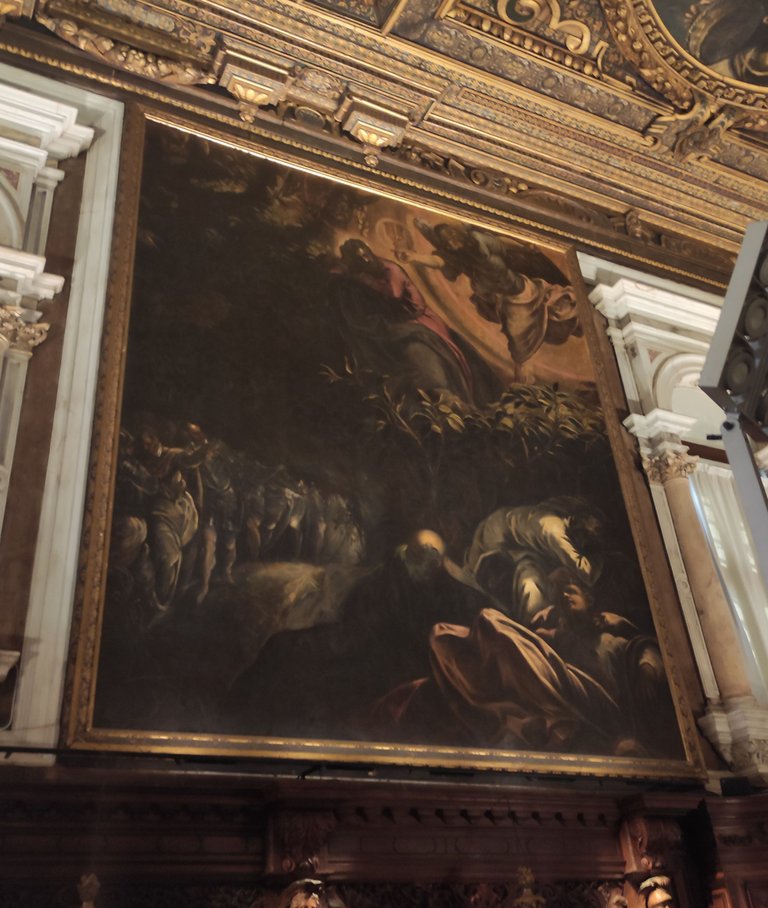
38
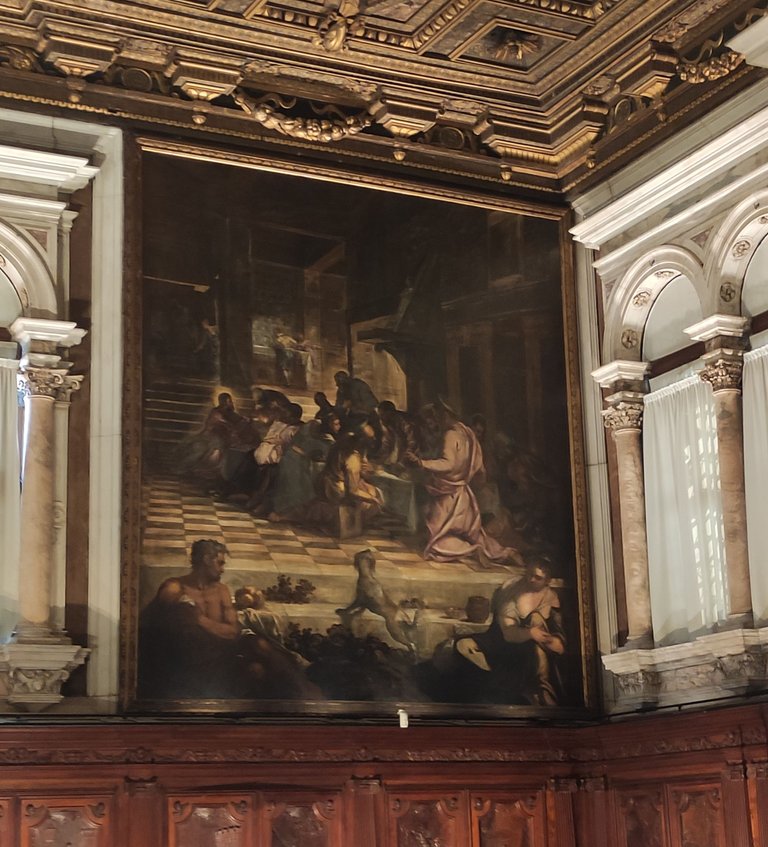
39
Description
Unusual perspective that gives depth and symbolically brings the table of the guests towards the altar in the background. Jesus is the smallest figure to represent his humility in a simple environment where everything takes place in the apparent daily life.
Descrizione
Prospettiva inusuale che da profondità e simbolicamente porta la tavola dei commensali verso l’altare di fondo. Gesù è la figura più piccola per rappresentarne l’umiltà in un ambiente semplice in cui tutto si svolge nell’apparente quotidianità.
On the right wall from the presbytery:
Multiplication of the loaves and fish -40-
Nella parete destra dal presbiterio:
Moltiplicazione dei pani e dei pesci -40-
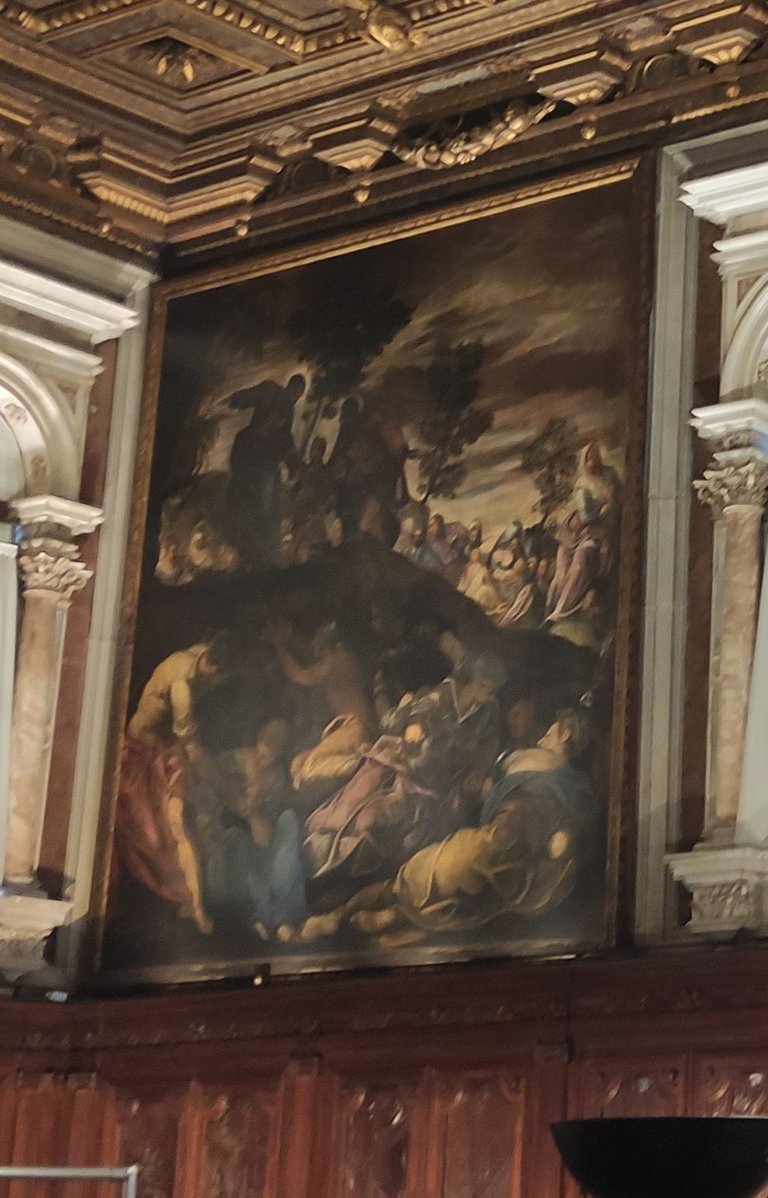
40
Description
The pictorial rendering of the painting is peculiar, the color of which diluted with a lot of oil drips into the canvas as if to represent on the one hand the weight of materiality and at the same time to symbolize the imperfection of the painter himself.
Descrizione
Peculiare la resa pittorica del quadro il cui colore diluito con molto olio cola nella tela come a rappresentare da un lato il peso della materialità e nel contempo a simboleggiare l’imperfezione dello stesso pittore.
Raising of Lazarus -41-
Ascension -42-
Probatic pool -43-
Resurrezione di Lazzaro -41-
Ascensione -42-
Piscina Probatica -43-
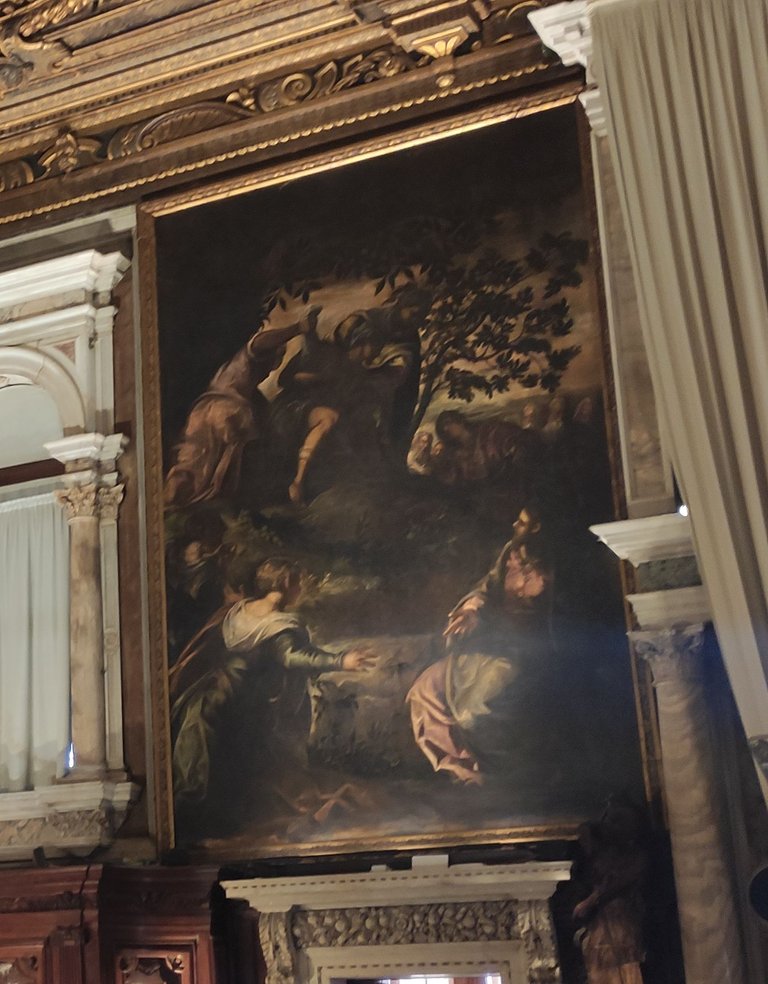
41
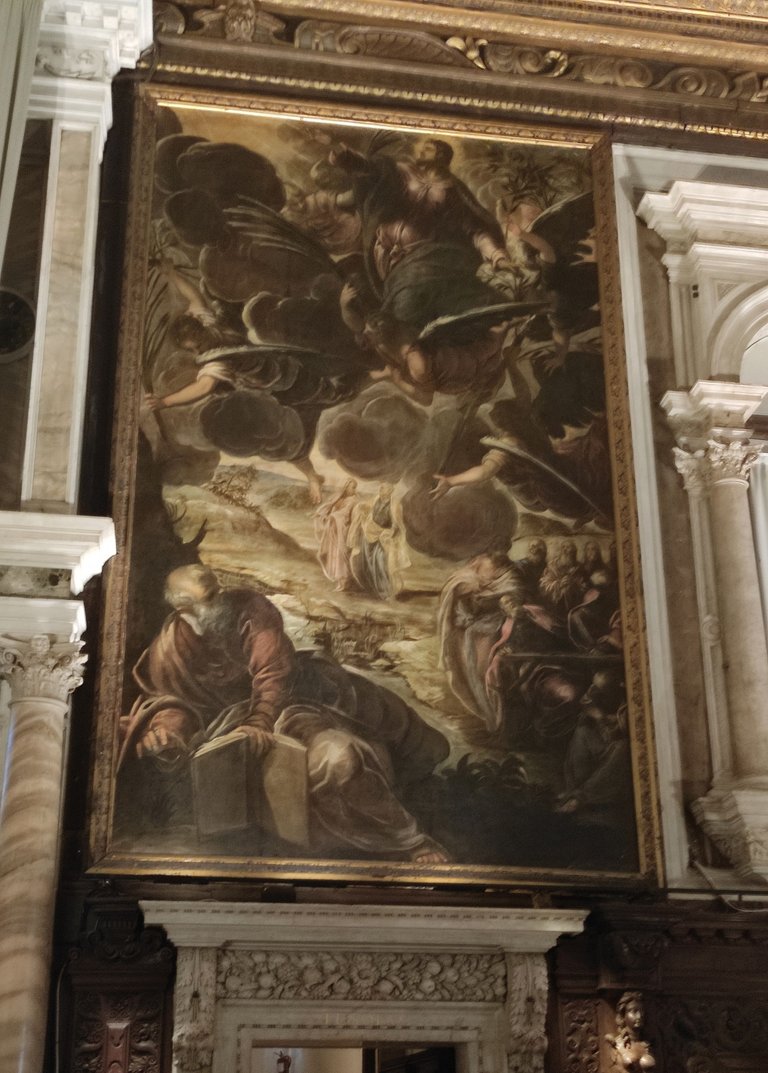
42
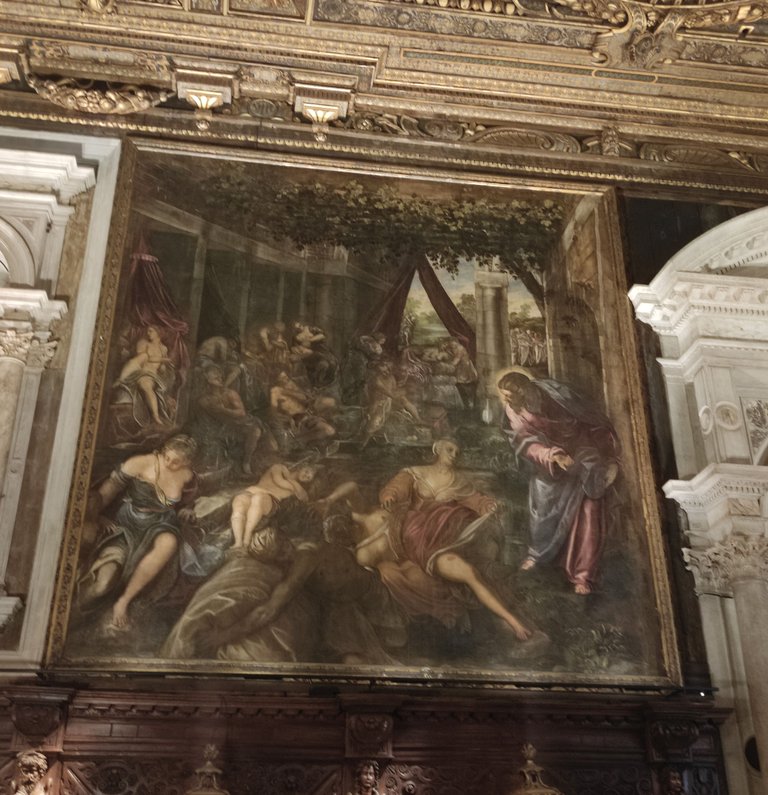
43
Description
The biblical episode is totally revisited compared to tradition. The narration of the biblical episode of the healing of the paralytic is inserted in a spatial illusion through the low coffered roof in perspective opposed to the characters, in a plane in front, who are witnessing the miracle, seems to emerge from the canvas.
Descrizione
L’episodio biblico è totalmente rivisitato rispetto alla tradizione. La narrazione dell’episodio biblico della guarigione del paralitico è inserita in una illusione spaziale attraverso il tetto basso a cassettoni in prospettiva contrapposto ai personaggi, in un piano antistante, che stanno assistendo al miracolo, sembrano emergere dalla tela.
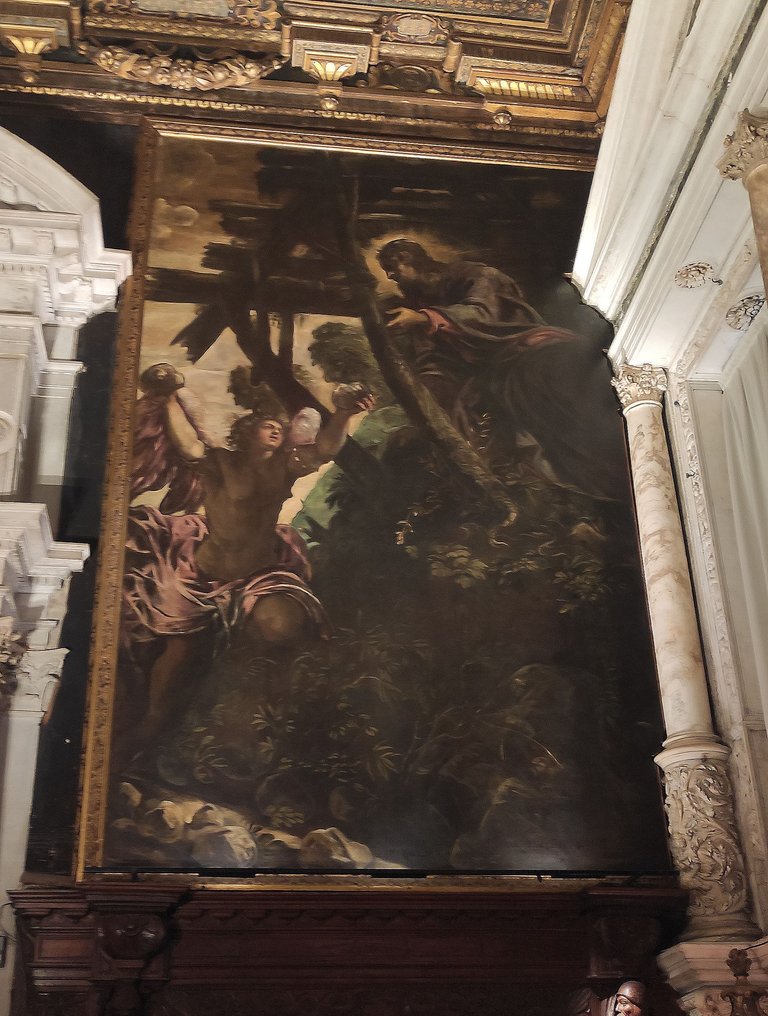
44
Description
The composition is on two levels where the two plastic figures of Christ emerge in the act of rejecting a beautiful tempting Satan. The scene is represented through bright colors that range from the green of the vegetation to the red of the draped garments.
Descrizione
la composizione è su due livelli in cui emergono le due figure plastiche di Cristo nell’atto di respingere un bellissimo Satana tentatore. La scena è rappresentata attraverso colori vivaci che vanno dal verde della vegetazione al rosso delle vesti drappeggiate.
Sala Capitolare Scheme / Schema

SALA DELL'ALBERGO
English
And from here we go to the last room of the "Albergo" where the brothers originally gathered, sees the "Passion of Christ" represented and chronologically.
It is the first room from which Tintoretto gives way to his pictorial cycles which in the span of the years 1564 to 1588 will see the artist engaged within the school that becomes a sort of mystical refuge where Tintoretto expresses spirituality through painting.
It all begins with a competition, held by the brotherhood, for a canvas to be affixed to the ceiling of the hotel room depicting San Rocco. There were many participating artists and a cartoon with the drawing was required to entrust the order and then it would be decided who to entrust the work to.
Tintoretto, as well as having many enmities that hindered him in the artistic path, did not perform very well in his pencil works so he would have found himself very disadvantaged for the performance of his work, therefore he used a stratagem to ensure the first step that would have allowed him, then, to decorate the rest of the school.
in fact, thanks to the help of some of the brothers, he realized the canvas in the requested format and affixed it to the ceiling of the room and knowing that the brotherhood could not refuse donations, he gives his work for free , succeeding in this way to grab the order with a broader vision of decorating the rest of the room.
Surrounded by allegorical figures that decorate the entire perimeter of the ceiling from 2 to 17 , in the center of the ceiling we find the canvas of:
Italiano
L’ultima Sala dell’Albergo dove originariamente si riunivano i confratelli, vede rappresentata la Passione di Cristo è cronologicamente la prima sala da cui Tintoretto da il via ai suoi cicli pittorici che nell’arco degli anni 1564 al 1588 vedranno l’artista impegnato all’interno della scuola che diviene una sorta di rifugio mistico dove il Tintoretto esprime la spiritualità attraverso la pittura.
Tutto inizia con un concorso, indetto dalla confraternita, per un telario da apporre nel soffitto della sala dell’albergo raffigurante San Rocco.
Gli artisti partecipanti erano tanti e si richiedeva, per affidare la commessa, un cartone con il disegno e poi si sarebbe deciso a chi affidare il lavoro.
Il Tintoretto oltre che avere molte inimicizie che lo ostacolavano nel cammino artistico, non rendeva molto bene nei suoi lavori a matita per cui si sarebbe trovato molto svantaggiato per la resa del suo lavoro, quindi adopera uno stratagemma per assicurarsi il primo passo che gli avrebbe permesso, poi, di decorare il resto della scuola.
Infatti grazie all’aiuto di qualcuno dei confratelli, realizza la tela nel formato richiesto e la appone nel soffitto della sala e sapendo che la confraternita non poteva rifiutare le donazioni, egli dona il suo lavoro riuscendo così di fatto ad accaparrarsi la commessa con una visione più amplia di decorare il resto della sala.
Attorniato da figure allegoriche che decorano tutto il perimetro del soffitto da 2 a 17, al centro del soffitto troviamo la tela di:
San Rocco in Glory -1-
San Rocco in Gloria -1-
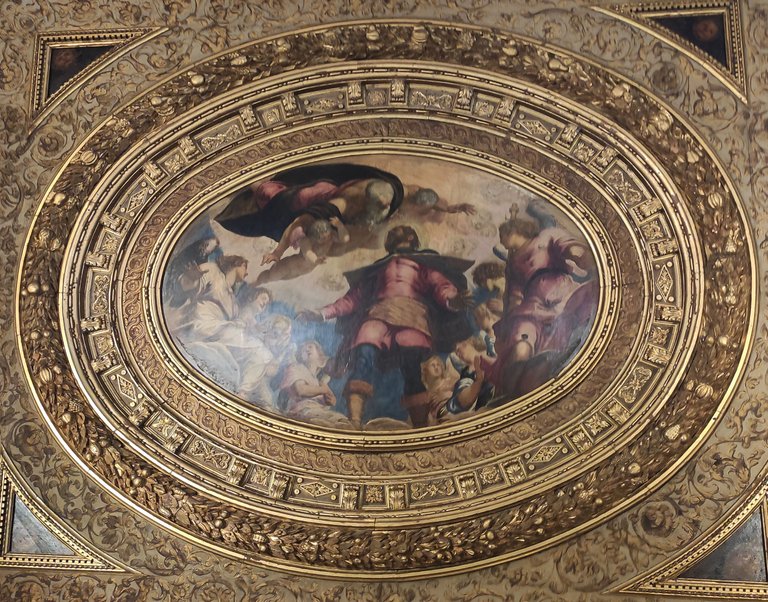
1
Description
It has an elliptical shape and the composition on two floors recalls the assumption of Titian for the ascending perspective vision and the Michelangelo depiction of the separation of the earth from the waters, then uses ultramarine blue with crimson and purple in contrast for an optical effect of prominence of the figure surrounded by the divine light.
Descrizione
Ha forma elittica e la composizione su due piani richiama l’assunta di Tiziano per la visione prospettica ascendente e il la raffigurazione michelangiolesca della separazione della terra dalle acque, poi usa in contrapposizione blu oltremare con cremisi e viola per un effetto ottico di risalto della figura attorniata dalla luce divina.
In the large back wall he was commissioned to paint:
The Crucifixion -18-
Nella grande parete di fondo gli viene commissionato:
La Crocifissione -18-
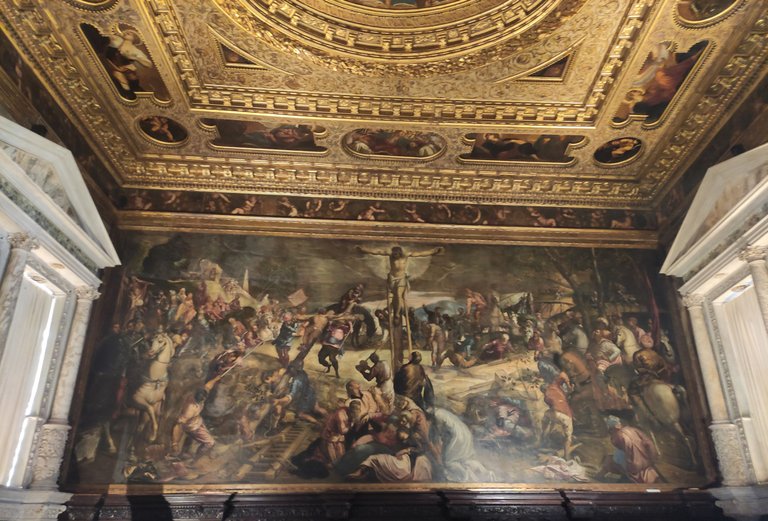
18
Description
It occupies the entire wall and is about 12 meters wide in a room with limited space that does not allow the observer to immediately grasp the work.
Actually the scenic style of Tintoretto allows to overcome the problem by making the scene in progress and extremely mobile thanks to the two vanishing points placed on the sides of the representation than verge on the cross of the scene on the right and the group of spectators on the left
The scene appears in the making for the observer who enters the room to which the scene of the figures at the foot of the cross of Christ is presented in the foreground and then sweeps through the event of the crucifixion by entering the room with a vision of an ensemble that finds in the background of the picture a normality extraneous to the narrated fact like the donkey in the background that eats palm leaves, an allegorical detail full of meaning.
Tintoretto signs the work with a play on words "Tintor rectus" wanting to affirm his faith as a righteous dyer and at the same time that the brotherhood's commission had been unanimous in entrusting him with the order.
Descrizione
Occupa tutta la parete ed è larga circa 12 metri in una sala con spazio limitato che non permette all’osservatore di cogliere l’opera immediatamente,
infatti lo stile scenico del Tintoretto permette di ovviare il problema rendendo la scena in divenire ed estremamente mobile grazie ai due punti di fuga posti ai lati della rappresentazione che vanno a convergere nella croce della scena a destra e il gruppo di spettatori a sinistra.
La scena si presenta in divenire per l’osservatore che accede alla sala a cui si presenta in primo piano la scena delle figure ai piedi della croce del Cristo per poi spaziare nell’evento della crocifissione accedendo all’interno della sala con una visione d’insieme che trova nello sfondo del quadro una normalità estranea al fatto narrato come l’asino nel fondo che mangia le foglie di palma, particolare allegorico e pregno di significato.
Il Tintoretto firma l’opera con un gioco di parole “Tintor rectus” a voler affermare la sua fede come retto tintore e nello stesso tempo che la commissione della confraternita era stata unanime ad affidargli la commessa.
Made from 1566 to 1567 on the wall facing the crucifixion from left to right, he affixes the paintings of:
Christ in front of Pilate -19-
Realizzati dal 1566 al 1567 nella parete di fronte alla crocifissione da sinistra a destra appone le tele di :
Cristo davanti a Pilato -19-
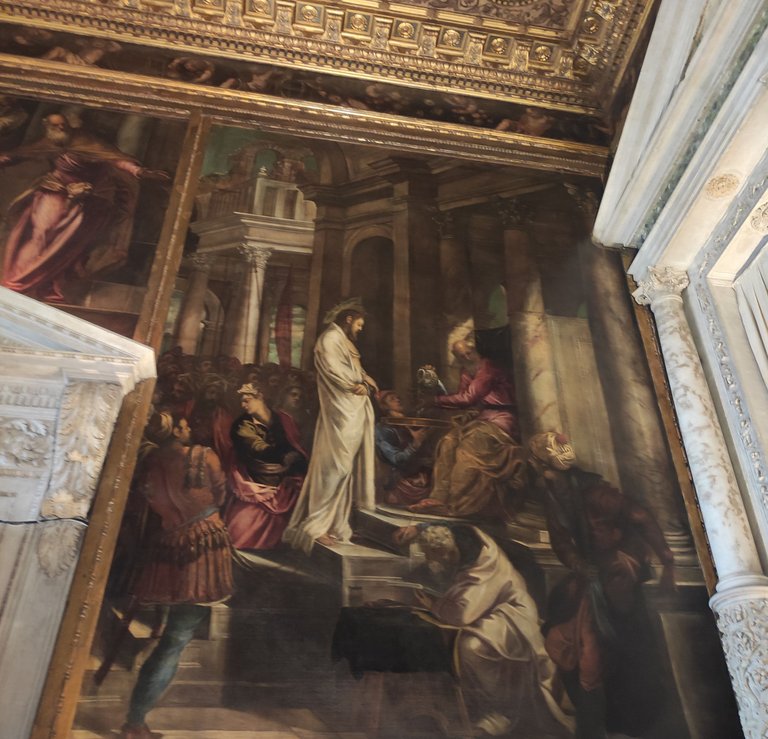
19
Description
We find a scenic continuation with the crucifixion to link the moments of the passion of Christ in consequentiality.
He uses the same chromatic table to bring out the topical moment in which Christ is represented with a white draped cloak that detaches him clearly from the crimson of the garments of the other actors in the scene.
Descrizione
Troviamo una continuazione scenica con la crocifissione per legare i momenti della passione di Cristo nella consequenzialità.
Usa la stessa tavola cromatica per far risaltare il momento topico in cui Cristo è rappresentato con un manto panneggiato bianco che lo stacca di netto dal cremisi delle vesti degli altri attori della scena.
Ecce Homo -20-
Ecce Homo -20-

20
Description
The reduced spatial setting leads to an authentic composition showing a semi-reclining Christ adapting to the triangular shape of the stage space.
The armor stands out for its plastic accuracy and detail rendering, which focuses the perspective attention of the first floor, the warm colors of crimson emphasize the figures.
Descrizione
L’impostazione spaziale ridotta, porta ad una composizione autentica mostrando un Cristo semi disteso che si adatta alla forma triangolare dello spazio scenico.
Risalta per l’accuratezza plastica e la resa dei dettagli l’armatura la quale accentra l’attenzione prospettica del primo piano, i colori caldi del cremisi danno risalto alle figure.
Ascent to Calvary -21-
Salita al Calvario -21-

21
Description
It takes up the setting of the crucifixion as if to indissolubly tie events in continuity.
We find the narrative dynamism, as in existence, through the first figure on the left who, weighed down by the cross, travels a diagonal to the right and the Christ who, in the upper part of the composition, imaginatively travels a diagonal from right to left almost to create a movement that leads back towards the crucifixion.
Descrizione
Riprende l’ambientazione della crocifissione come a legare indissolubilmente gli eventi nella continuità.
Troviamo il dinamismo narrativo, come in essere, attraverso la prima figura a sinistra che gravato dalla croce percorre una diagonale verso destra e il Cristo che, nella parte superiore della composizione, immaginariamente percorre una diagonale da destra a sinistra quasi a creare un movimento che li riconduce verso la crocifissione.
Sala dell'Albergo Scheme / Schema

And It is over...
I hope you enjoyed this "virtual" trip inside the magnificent Scuola Grande di San Rocco, with one of the greatest exponents of Venetian painting and Mannerist art in general
It took me a lot of effort to do this blog, but I hope that you find it interesting and that enrich you culturally
E siamo arrivati alla fine...
Spero che vi sia piaciuta questa visita "virtuale" all'interno della magnifica Scuola Grande di San Rocco, con i dipinti di uno dei più grandi esponenti della pittura Veneziana e dell'arte Manierista in generale.
Mi è costata molta fatica fare questo blog, ma spero ne sia valsa la pena e che lo troviate interessante e vi arrichisca culturalmente.
Here is a little bonus video made inside La Sala Capitolare... https://odysee.com/@archimax72:4/SalaCapitolare:e?r=HfV93APaeprQaCa8r5RriPN3irEHzQ1T
Hiya, @ybanezkim26 here, just swinging by to let you know that this post made it into our Honorable Mentions in Daily Travel Digest #1348.
Your post has been manually curated by the @pinmapple team. If you like what we're doing, please drop by to check out all the rest of today's great posts and consider supporting other authors like yourself and us so we can keep the project going!
Become part of our travel community:
Congratulations, your post has been added to Pinmapple! 🎉🥳🍍
Did you know you have your own profile map?
And every post has their own map too!
Want to have your post on the map too?
Congratulations @archimax72! You have completed the following achievement on the Hive blockchain and have been rewarded with new badge(s) :
Your next target is to reach 100 comments.
You can view your badges on your board and compare yourself to others in the Ranking
If you no longer want to receive notifications, reply to this comment with the word
STOP